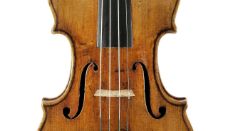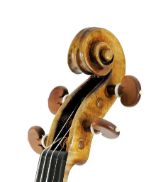Violin, Antonio Stradivari, Cremona 1722, “ex Kreisler”-“ex Rawack”
Printed label: “Antonius Stradiuarius Cremonensis / Faciebat Anno 1722” (722 handwritten)This violin is from Stradivari’s late career – he was approaching his 80th birthday. By that time, his two sons, Francesco (* 1671) and Omobono (* 1679) had already become experienced luthiers who worked in their father’s shop. Their collaboration on the execution of the instruments built after 1720 is evident in details, but this does not affect the instruments’ tonal potential. The 1722 violin was probably built on the “P” inner mold, which is housed at the Museo del Violino in Cremona (inventory no. MS 44). Some of Stradivari’s best-sounding violins were built on this large inner mold. The wood of the two-part belly is very fine-grained in the center, with the annual rings growing wider toward the edges. The two halves of the belly are not from the same log and were dated 1688 (bass side) and 1694 (treble side). Both halves have very high correlations with other Italian instruments, especially ones made by Stradivari. Like the violins from 1716 (“ex Baron Oppenheim”) and 1725 (“Chaconne”), this violin has a small knot above the f-hole on the bass side. The one-piece, quarter-cut back has broad, irregular flames that descend slightly toward the bass side. The ribs and the head show somewhat tighter flames. The arching is flat and exhibits very harmonious curves. A slight asymmetry of the f-holes can be detected. The volutes of the scroll are cleanly executed and very regular in structure. As with many of Stradivari’s instruments, the chamfers of the volutes were originally blackened with varnish. A very clear, orange-red color varnish coats a golden-yellow ground.
For this violin, the chain of title can be established from the late 19th century. Its first prominent owner was violinist Fritz Kreisler (1875–1962). Kreisler was only seven years old when he was accepted as a student of the Vienna Conservatory. He completed his studies in Paris. In 1887, Kreisler won the highly prestigious Grand Premier Prix of the Paris Conservatory. On his return to Vienna, his career took off. Kreisler performed his first concert with the Vienna Philharmonic under the baton of Hans Richter in 1898, playing a 1732 Stradivari that had been lent to him. The records of W. E. Hill & Sons note that Kreisler owned the Stradivari violin presented here from 1897/1898, but sold it in 1901.
This 1722 Stradivari used to be known as “ex Rawark,” an incorrect spelling of the previous owner’s name, Margarete Rawack. A note handwritten by Rawack has been preserved and became known during the 1983 auction of the violin. Incorrect reading led to the wrong name. Margarete Rawack was born on June 29, 1877, in Beuthen, Upper Silesia, and studied with Joseph Joachim in Berlin from 1903 to 1907. She is assumed to have worked mainly as a teacher subsequently, and from 1925, she was a member of a women’s string quartet in Berlin. As she was of Jewish descent, her authorization to teach was withdrawn in 1933, depriving her of her livelihood. Around 1939 or 1940, she emigrated to Harrow in England. In the above-mentioned note dated 1955, Rawack records that she had already given the instrument to her nephew Wolfgang Michaelis in 1927, but that she was permitted to use it as long as she lived. Michaelis’s successors auctioned off the violin at Sotheby’s in 1983.






